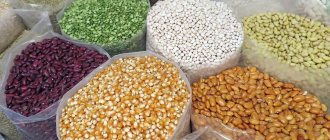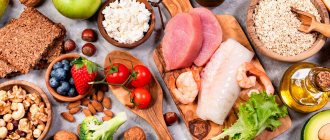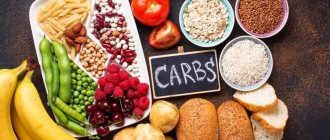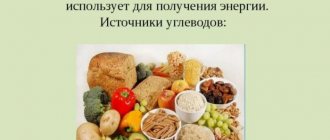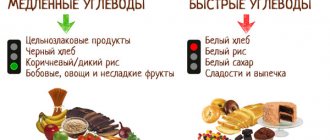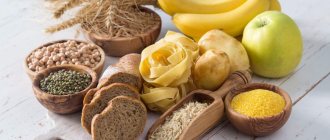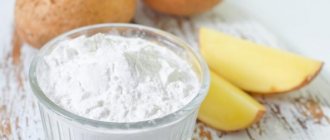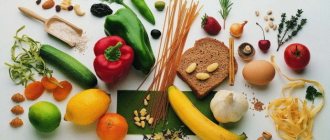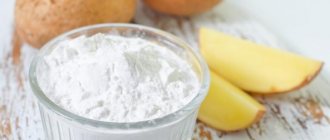Recently, topics such as low-carbohydrate diets, calculating fatty acids and balanced nutrition have become especially popular. According to many people, you need to minimize the consumption of foods that are rich in carbohydrates. However, this statement cannot be called completely correct, because these organic substances are represented by several types, which, in turn, have different properties. Carbohydrates are an integral part of any diet and are present every day in the diet of people, including those who play sports and adhere to a healthy lifestyle. To figure out whether fast carbohydrates are useful, products with which organic substances can be consumed during weight loss or as part of a balanced diet, it is worth learning about the types and properties of these organic substances.
Types of carbohydrates
Simple
. This category includes connections:
- lactose (found only in dairy products),
- glucose,
- sucrose,
- fructose.
Organic substances quickly enter the human blood, which causes a sharp increase in glucose in the body. Our defense mechanisms try to correct the situation, so the compounds are often transformed into fat reserves, and the feeling of hunger soon reappears. If we talk about products that contain simple (fast) carbohydrates, then these are mainly honey, various fruits and berries, as well as sugar, regardless of the type. For example, refined sugar consists almost entirely of sucrose, which is the sweetest carbohydrate.
Complex
. Unlike the previous category, these organic substances, on the contrary, are slowly processed and absorbed by the body, due to which they feed the muscles with energy for a long time. Complex carbohydrates include:
- dietary fiber,
- starch,
- glycogen.
Among the products, these are primarily whole grain cereals, durum wheat pasta, various legumes (including beans) and green vegetables.
What are the dangers of a lack of carbohydrates?
When the body is deprived of its main source of energy, it immediately begins to sound the alarm - this is how it manifests itself:
- dehydration - with a deficiency of carbohydrates, muscles become “donors” of energy, and they consist of 75% water - fluid reserves at this moment are depleted;
- problems with the gastrointestinal tract - beneficial bacteria feed on fiber in complex carbohydrates, and an excess of fatty and protein foods will lead to constipation and bloating;
- poor health - the body takes a lot of energy to break down fats instead of carbohydrates, plus sugar is closely related to the level of dopamine and good mood (the hormone of joy);
- overeating - slow carbohydrates keep you feeling full for a long time - this is due to the fiber in their composition - it gives volume to food and increases the production of hormones GLP-1 and peptide YY - they reduce appetite.
Synthesis of glucose from polysaccharides
The body can obtain simple carbohydrates from complex carbohydrates. In this process, one of the important energy units is glucose. It is synthesized by the body independently from polysaccharides. Reserves include:
- glycogen is a substance that accumulates in the cells and muscles of the liver. We get glycogen from sweets, flour products and fruits;
- starch - it is the basic source used for the synthesis of glucose. It is no secret to many that this polysaccharide is found in large quantities in potatoes and cereals.
Structural polysaccharides include:
- Pectin is another source of glucose, as well as a body cleanser. In marmalade and similar confectionery products, pectin is contained in high concentrations. In the food industry, such a substance is used as a thickener and is labeled as E440;
- Cellulose is a specific type of carbohydrate that is not digested, but can provide cleansing of the body and normal digestion. Cellulose (fiber or dietary fiber) is found in vegetables, fruits, bran and grain products.
Table of products by GI level
Do you want to normalize your weight? Review your diet, increase the amount of slow carbohydrates by reducing fast ones. The initial stage can be difficult, since guessing the glycemic index of foods is not easy. A food table will help you create a healthy diet.
| Products | GI |
| Crustaceans (lobster, crab, lobster) | 5 |
| Spices (basil, oregano, cumin, cinnamon, vanilla, etc.) | 5 |
| Vinegar | 5 |
| Avocado | 10 |
| Peanut | 15 |
| Soybeans | 15 |
| Green peas | 15 |
| Mushrooms | 15 |
| Cereal germ | 15 |
| Ginger | 15 |
| Zucchini | 15 |
| White cabbage | 15 |
| Broccoli | 15 |
| Brussels sprouts | 15 |
| Sauerkraut | 15 |
| Cauliflower | 15 |
| Gherkin | 15 |
| Onion | 15 |
| Leek | 15 |
| Shallot | 15 |
| Lupine | 15 |
| Almond | 15 |
| Cucumber (ripe, fresh vegetables) | 15 |
| Pickled cucumbers | 15 |
| Olives | 15 |
| Walnut | 15 |
| Hazelnut (hazelnut) | 15 |
| Pine nuts | 15 |
| Cashew nuts | 15 |
| Bran (wheat, oat) | 15 |
| Sweet pepper | 15 |
| Chili pepper, capsicum | 15 |
| Pesto (sauce) | 15 |
| Sprouted grains (wheat, soy, etc.) | 15 |
| Rhubarb | 15 |
| Radish | 15 |
| Carob powder (thickener) | 15 |
| Iceberg lettuce (leaf, arugula and other products) | 15 |
| Beetroot | 15 |
| Celery (stems) | 15 |
| Agave syrup | 15 |
| Black currant (fresh berries) | 15 |
| Asparagus | 15 |
| Tempeh (from fermented soybeans) | 15 |
| Tofu (bean curd) | 15 |
| Green beans | 15 |
| Fennel | 15 |
| Physalis | 15 |
| Pistachios | 15 |
| Zucchini | 15 |
| Spinach | 15 |
| Sorrel | 15 |
| Endive | 15 |
| Artichoke | 20 |
| Acerola (Barbados cherry) | 20 |
| Eggplant | 20 |
| Bamboo shoots | 20 |
| Sugar free jam (Montignac) | 20 |
| Soy yogurt (natural) | 20 |
| Cocoa powder (sugar-free product) | 20 |
| Lemon (fresh or ripe fruit) | 20 |
| Palm pulp | 20 |
| Ratatouille | 20 |
| Soy products | 20 |
| Soy cream | 20 |
| Soy sauce (sugar-free product) | 20 |
| Lemon juice (sugar-free product) | 20 |
| Fructose (from sugar beet, European) | 20 |
| Dark chocolate (85% cocoa) | 20 |
| Soybeans, canned | 22 |
| Peanut butter (sugar-free product) | 25 |
| Cherry (fresh berries) | 25 |
| Blueberries (fresh berries) | 25 |
| Dry peas | 25 |
| Blackberries (fresh berries) | 25 |
| Strawberry (fresh berry) | 25 |
| Barley groats | 25 |
| Gooseberry | 25 |
| Raspberry (fresh berry) | 25 |
| Cloudberry (fresh berry) | 25 |
| Soy flour | 25 |
| Hazelnut butter (sugar-free product) | 25 |
| Unshelled almond paste (sugar-free product) | 25 |
| Red currant (fresh berries) | 25 |
| Pumpkin seeds | 25 |
| Mungo beans | 25 |
| Flajole beans | 25 |
| Hummus | 25 |
| Blueberries (fresh berries) | 25 |
| Green lentils | 25 |
| Dark chocolate (70% cocoa) | 25 |
| Apricot (fresh) | 30 |
| Vermicelli soy | 30 |
| Grapefruit and pomelo (fresh or ripe fruit) | 30 |
| Pear (fresh or ripe fruit) | 30 |
| Jam (no sugar, with fruit juice) | 30 |
| Mandarin, clementine | 30 |
| passion fruit | 30 |
| Marmalade (no sugar) | 30 |
| Almond milk | 30 |
| Oat milk (raw) | 30 |
| Soy milk | 30 |
| Powdered milk** | 30 |
| Milk** (any fat content) | 30 |
| Carrots (fresh) | 30 |
| Chickpeas | 30 |
| Oat (oyster) root | 30 |
| Beetroot (fresh) | 30 |
| Scorzonera (goat) | 30 |
| Rennet cheese** | 30 |
| Cottage cheese** not pressed | 30 |
| Tomatoes | 30 |
| Turnips, turnips (fresh) | 30 |
| Green beans | 30 |
| Garlic | 30 |
| Yellow lentils | 30 |
| Brown lentils | 30 |
| Chocolate milk | 34 |
| Whole grain bread "Montignac" | 34 |
| Quince (fresh or ripe fruit) | 35 |
| Amaranth (seeds) | 35 |
| Anona (carom, "starfruit") | 35 |
| Orange (fresh or ripe fruit) | 35 |
| Durum wheat vermicelli | 35 |
| Green peas (fresh) | 35 |
| Mustard, Dijon | 35 |
| Pomegranate (fresh or ripe fruit) | 35 |
| Baker's yeast | 35 |
| Brewer's yeast | 35 |
| Figs (fresh or ripe fruit) | 35 |
| Natural yogurt** | 35 |
| Soy yogurt (flavored) | 35 |
| Cassoulet | 35 |
| Quinoa | 35 |
| Indian corn | 35 |
| Fresh corn | 35 |
| Sesame seed | 35 |
| Dried apricots | 35 |
| Flax-seed | 35 |
| Maize | 35 |
| poppy seed | 35 |
| Almond butter (sugar-free product) | 35 |
| Soy milk ice cream | 35 |
| Creamy ice cream (fructose) | 35 |
| Chickpea flour | 35 |
| Nectarine (fresh or ripe fruit) | 35 |
| Chickpeas (canned) | 35 |
| Prickly pear (fresh or ripe fruit) | 35 |
| Peeled almond paste (sugar-free product) | 35 |
| Peach (fresh or ripe fruit) | 35 |
| Sunflower (sunflower seeds) | 35 |
| Wild rice | 35 |
| Celery root (raw) | 35 |
| Plums (fresh or ripe fruit) | 35 |
| Tomato juice | 35 |
| Tomato juice | 35 |
| Tomato sauce (sugar-free product) | 35 |
| Dried tomatoes | 35 |
| Falafel (chickpea) | 35 |
| Adzuki beans | 35 |
| White beans | 35 |
| Borpotti beans | 35 |
| Red beans | 35 |
| Black beans | 35 |
| Sprouted grain bread | 35 |
| Wasa crispbread with fiber (24%) | 35 |
| Chocolate bars (sugar free) | 35 |
| Dried apples | 35 |
| Apple (fresh or ripe fruit) | 35 |
| Baked apple | 35 |
| Applesauce | 35 |
| Applesauce (sugar-free product) | 35 |
| Lima bean soup | 36 |
| Peanut butter (sugar-free spread) | 40 |
| Beans, fava (raw) | 40 |
| Pear melon | 40 |
| Quince jelly (sugar-free product) | 40 |
| Dried figs | 40 |
| Whole grain kamut | 40 |
| Buckwheat porridge | 40 |
| Buckwheat | 40 |
| Sesame paste, tahini | 40 |
| Lactose | 40 |
| Matzo (whole wheat flour) | 40 |
| Coconut milk | 40 |
| Quince flour | 40 |
| Buckwheat flour | 40 |
| Quinoa flour | 40 |
| Oats | 40 |
| Oat flakes (unprocessed) | 40 |
| Whole wheat pasta cooked al dente | 40 |
| Shortbread cookies (whole grain flour, no sugar) | 40 |
| Spelled | 40 |
| Dry cider | 40 |
| Carrot juice (sugar-free product) | 40 |
| Sorbet (sugar-free product) | 40 |
| Spaghetti cooked in 5 minutes | 40 |
| Takhin | 40 |
| Falafel (from beans, fava) | 40 |
| Red beans (canned) | 40 |
| Whole grain flour bread (100%) yeast | 40 |
| Pumpkin bread | 40 |
| Chicory (drink) | 40 |
| Prunes | 40 |
| Lentil soup | 44 |
| Pineapple (fresh or ripe fruit) | 45 |
| Orange juice (sugar-free product) | 45 |
| Dessert banana (green) | 45 |
| Plantain banana (raw) | 45 |
| Whole grain bulgur (finished product) | 45 |
| Grapes (fresh berries) | 45 |
| Green peas (canned) | 45 |
| Jam (no sugar, with grape juice) | 45 |
| Whole grain cereals (sugar-free product) | 45 |
| Capellini (a type of pasta, thinner than spaghetti) | 45 |
| Cranberry (fresh berry) | 45 |
| Coconut | 45 |
| Whole grain couscous, whole grain semolina | 45 |
| Kamut flour (whole wheat) | 45 |
| Spelled flour (whole grain) | 45 |
| Whole grain rye flour | 45 |
| Muesli "Montignac" | 45 |
| Spelled (whole grain) | 45 |
| Basmati rice, unpeeled | 45 |
| Grapefruit juice (sugar-free product) | 45 |
| Tomato sauce (with added sugar) | 45 |
| Whole grain toast | 45 |
| Grilled bread, made from whole grain flour, without sugar | 45 |
| Kamut bread | 45 |
| Pumpernickel bread "Montignac" | 45 |
| Whole grain rye bread | 45 |
| Whole grain bread (made from whole grain flour) | 45 |
| Fruit bread | 47 |
See the full glycemic index table of foods *Foods with less than 5% carbohydrate content, so their glycemic load index is low and can be consumed in moderation without risk.
** Dairy products, because, despite the low glycemic index, they have a high insulin index, so they should be consumed with caution. When creating a menu, consider the lifestyle you lead. You don't have to completely give up fast carbohydrates. They will be useful for recuperating after intense physical training and during active mental activity (during exams). If you give up sweets, a loss of strength is guaranteed. High GI foods will help you recover quickly.
If you have a sedentary lifestyle, focus on low GI foods. If you are planning to lose weight, consult your doctor or nutritionist to choose the right diet.
Fast carbohydrates: to eat or not
Having learned more about such organic substances, you can more carefully plan your balanced diet. There is no need to completely give up simple carbohydrates. Otherwise, a person may feel tired, weak, irritable and in a bad mood, and this is completely useless. If you want to lose weight, then you should limit your consumption of sweets, flour and sugar. One of the options for control is regular calorie counting or a pre-compiled daily or weekly nutrition plan based on the KBJU that is suitable for you. If you play sports, then after an intense workout you can eat a small bar or cookie during the carbohydrate window, that is, almost immediately after physical activity.
Which carbohydrates are needed for weight gain and which for weight loss? How to use them correctly
For sports purposes, both types of carbohydrates are important - each of them has its own role and benefits (portion sizes, calorie content and product quality also need to be taken into account):
Gaining muscle mass:
- fast carbohydrates - consume half an hour before and after training. In the first case, you will spend them faster than they have time to be deposited in fat, in the second, they will go straight to replenish glycogen reserves in the muscles (no need to worry about excess weight);
- slow carbohydrates – consume 1-2 hours before and after training. In the first case, the energy will last until the end of the session, in the second, the muscles will also recover and grow, but more slowly.
Weight loss:
- fast carbohydrates - you shouldn’t give them up completely, especially when losing weight - this can lead to breakdowns;
- Slow carbohydrates – save you from overeating and are not stored in reserve. While they are digesting, you feel full.
BZhU and their features of conversion into energy
When choosing a packaged product, we can look at the label for the composition, weight and distribution of proteins, fats and carbohydrates (that is, nutritional value). Each of these elements has its own properties and characteristics of transformation into energy when it enters the body. For a person to feel good, it is important to consume a sufficient amount of dietary supplements, vitamins and microelements. Fats are the most energy-intensive nutrient, carbohydrates occupy a middle position, and proteins, in principle, are not always a source of energy. Carbohydrates are broken down much faster than fats, and less oxygen is consumed during this process. Energy is converted from proteins only when other nutrients are insufficient. To lose weight, there are indeed diets that involve eating only proteins and unsaturated fats. But these diets can be used strictly in the absence of medical contraindications and for a short period. In addition, if you completely give up carbohydrates for some time, it will be necessary to fill this “gap” with the proteins and unsaturated fats mentioned above.
What are the dangers of a lack of carbohydrates?
When the body is deprived of its main source of energy, it immediately begins to sound the alarm - this is how it manifests itself:
- dehydration - with a deficiency of carbohydrates, muscles become “donors” of energy, and they consist of 75% water - fluid reserves at this moment are depleted;
- problems with the gastrointestinal tract - beneficial bacteria feed on fiber in complex carbohydrates, and an excess of fatty and protein foods will lead to constipation and bloating;
- poor health - the body takes a lot of energy to break down fats instead of carbohydrates, plus sugar is closely related to the level of dopamine and good mood (the hormone of joy);
- overeating - slow carbohydrates keep you feeling full for a long time - this is due to the fiber in their composition - it gives volume to food and increases the production of hormones GLP-1 and peptide YY - they reduce appetite.
Why consider the glycemic index of foods
For an adult, a normal blood glucose level is considered to be between 4.1 and 5.9 mmol/l (depending on the laboratory, the upper and lower limits may differ slightly from those indicated). An indicator such as the glycemic index of foods affects blood glucose levels. It is carbohydrates that lower or increase “sugar” in the body. It is necessary to take into account the GI of foods if you want to lose weight or have health problems such as insulin resistance and diabetes. The higher the glycemic index, the faster carbohydrates are digested. And, accordingly, the level of glucose in the blood will increase. For this reason, preference should be given to slow carbohydrates, and fast carbohydrates should be limited or removed from the diet. From the table below it is clear that there is no relationship between the energy value of foods and GI. Thus, food may not be sweet at all, but have a high glycemic index.
| Product (100 g) | Glycemic index | Calorie content, kcal |
| Slow carbohydrates | ||
| Brown rice | 45 | 111 |
| Chickpeas | 30 | 364 |
| Fast carbohydrates | ||
| Semolina | 80 | 369 |
| White rice | 70 | 130 |
How many carbohydrates do men and women need per day?
The daily intake of carbohydrates depends on gender, age, weight, lifestyle and goals:
Women:
- lose weight – 50-55 kg (110 g), 60-65 kg (140 g), 70-75 kg (160 g), 80-85 kg (170 g);
- maintain weight – 50-55 kg (140 g), 60-65 kg (160 g), 70-75 kg (190 g), 80-85 kg (210 g);
- gain weight - 50-55 kg (190 g), 60-65 kg (240 g), 70-75 kg (250 g), 80-85 kg (260 g).
Men:
- lose weight – 50-55 kg (165 g), 60-65 kg (170 g), 70-75 kg (175 g), 80-85 kg (185 g);
- maintain weight – 50-55 kg (220 g), 60-65 kg (235 g), 70-75 kg (245 g), 80-85 kg (265 g);
- gain weight - 50-55 kg (280 g), 60-65 kg (295 g), 70-75 kg (310 g), 80-85 kg (320 g).
The percentage of carbohydrates in your daily caloric intake depends on your goals:
- less than 10% of total calories (reducing carbohydrates is usually used for medicinal purposes, such as for diabetics);
- 10-15% of the total calories (during weight loss for a short period of time, you can slightly limit carbohydrates, especially fast ones);
- 15-30% of total calories (suitable for those maintaining weight);
- more than 30% of total calories (athletes and those who want to gain muscle mass can increase the amount of carbohydrates).
Products containing polysaccharides
There are foods that contain only simple sugars or complex ones. How to prepare them so that they bring maximum benefit to the body? The following table shows which foods contain complex carbohydrates and how to properly prepare them for proper nutrition.
| Products | Group Description |
| Vegetables and greens | Most of them are found in vegetables and herbs. The richest of them: tomatoes, bell peppers, zucchini, leeks, celery, cabbage, spinach, lettuce. These vegetables contain virtually no calories, especially if eaten fresh. It’s good to steam vegetables or make smoothies out of them. They need to be cooked until half cooked, and some of the beneficial elements go into the decoction. High temperatures and prolonged cooking reduce the benefits of vegetables. |
| Berries and fruits | This group of products contains both difficult-to-digest carbohydrates and simple ones. The GI indicator is important here. They must be eaten raw. The most ideal are: kiwi, apples, figs, cherries, peaches and pomegranates. Some of them are: bananas, watermelon, mangoes and pineapples, which are very healthy, but they have a high GI. Canned food made from these products in its own juice does not lose its good quality. Of the dried fruits, dried apricots are considered the healthiest. Freshly squeezed juice without added sugar is healthy. |
| Dairy | This group does not contain complex carbohydrates, they only contain disaccharides. In addition to sugars, milk contains a lot of phosphorus, calcium, and vitamins. You can eat these products every day, but don’t overdo it. |
| Porridge | All whole grain porridges bring great benefits to the body. Such grains include oatmeal, bulgur, buckwheat, wheat and brown rice. It is not recommended to eat semolina and muesli. The best way to prepare cereals is to steam them with boiling water or kefir. Buckwheat or oats filled with kefir cleanse the body of harmful elements. |
| Cereals and legumes | This group of products contains a lot of fiber and is very useful for weight loss. From this group it is recommended to eat: bread and pasta made from coarse flour or whole grains, barley or oat flakes. Fiber stimulates intestinal motility, removes toxins and suppresses the feeling of hunger. And the group of legumes regulates carbohydrate levels and saturates the body with proteins. The best products: peas, chickpeas, lentils, boiled beans. |
| Beverages | Freshly squeezed juices from fruits, berries and vegetables always contain slow carbohydrates. There are a lot of them in tomato juice. In other drinks made from plant materials, there are not too many polysaccharides, but when you are on a diet for weight loss, it is right to drink a glass of juice for a snack rather than snack on a bun. |
When choosing foods, you should consider their calorie content. The more high-calorie ones are best eaten before lunch. With a sedentary lifestyle, it is necessary to limit foods high in polysaccharides in the diet. Knowing which foods contain complex carbohydrates and certain types of polysaccharides, you can safely eat them and not be afraid of gaining weight. It is important to eat a balanced diet, then metabolic processes will not be disrupted and the risk of gaining excess weight will not increase.
Carbohydrate diet for a week
The weekly diet includes the same products and provides three meals a day. However, if it is difficult for you to maintain long periods of time between meals, you can divide breakfast and lunch into two parts and give yourself snacks.
Day 1: egg and salad with spinach and tomato; vegetable stew, sliced green vegetables with butter; grilled chicken and salad with herbs.
2nd day: omelette, grapefruit; oven-baked meat with green beans; braised cabbage.
Day 3: yogurt with whole grain bread; lentil soup; meat stewed with mushrooms, leafy greens.
4th day: sandwich of rye bread and cheese; a piece of baked fish, a portion of brown rice; squid salad.
5th day: cottage cheese with dried fruits or nuts; steamed pollock and tomato juice; zucchini stewed with garlic.
6th day: tomatoes, 2 eggs; pea soup with croutons; stew with meat, green vegetable mix.
7th day: cottage cheese and apple; cabbage salad, boiled potatoes; fish stewed with vegetables.
Benefit
Complex sugars maintain the tone and balance of the body. Due to their low rate of breakdown, they give you a feeling of fullness for a long time. Foods high in polysaccharides have an extremely positive effect on the body. Among the main properties are:
- improving brain function;
- control and stabilization of muscle activity;
- reducing the risk of liver atrophy;
- participation in intracellular metabolism;
- removal of waste and toxins;
- improving the functioning of the gastrointestinal tract;
- maintaining energy levels throughout the day.
Sources of long-soluble glucose are useful not only for weight loss, they are also indispensable for type 1 and type 2 diabetes, obesity, atherosclerosis and various diseases of the cardiovascular system. Slowly digestible carbohydrates are broken down smoothly and gradually. The first glucose molecules are absorbed into the blood 40 minutes after eating. Then the product is digested for another 3 hours, giving the body a supply of vigor and strength.
Products containing polysaccharides are especially important for people involved in severe physical activity or strength training. Nutritionists advise those losing weight not to consume carbohydrates, even complex ones, at night. This puts a serious strain on the pancreas and liver, causing heaviness, nausea, and insomnia.
Why do we need sugar in the body?
Carbohydrates are required by the body to maintain energy. It produces approximately 60% of its energy from mono- and polysaccharides. And the rest is fats and proteins.
Please note: It should be noted that fast carbohydrates immediately return lost energy, but they themselves are quickly consumed and then the body signals for supplementation. Then polysaccharides come into play, they feed the body with fuel slowly but for a long time. The body especially requires heavy carbohydrates for those who do not like to sit in one place.
To feel energetic and not suffer from hunger, the ratio of carbohydrates should be as follows:
- polysaccharides – 70%;
- monosaccharides – 25%;
- fiber – 5% of the total amount of carbohydrates required.
This combination will allow you to save energy for sports and at the same time stabilize constant weight loss.
Video
List of foods rich in complex carbohydrates
Everyone knows that cereals contain a large amount of carbohydrates, but there are also a lot of them in legumes, fruits, and also in some vegetables. Taking this into account, the diet of a healthy person should consist of 50-60% of these products. Let's look at where exactly healthy carbohydrates are found.
Cereals. Of the wide variety of cereals, you should prefer buckwheat, quinoa, millet, and oats. But it is better to minimize the consumption of rice and semolina, since they are the least healthy (low fiber, high calories).
Fruits vegetables . They contain a large amount of dietary fiber, the benefits of which have already been mentioned above, as well as vitamins and microelements necessary for the body. However, fruits are best consumed in moderation due to their high sugar content. Sometimes you can drink fruit and vegetable juices and smoothies, but they will no longer contain as much fiber, which is important for us, so it is better to prefer an apple or carrot in its usual form.
Greenery. It is advisable to consume it with any meal. It has a great effect on digestion and provides the body with nutrients.
Dairy products. You should choose natural yogurt without additives, low-fat kefir and cottage cheese.
Legumes. An excellent source of not only carbohydrates, but also vegetable protein. An excellent product that helps maintain carbohydrate balance.
Let's see how much complex carbohydrates are contained in different foods. The table will especially help those who need to monitor their intake of this nutrient.
Cereals
| Grocery list | Number of carbohydrates in 100 grams |
| Amaranth | 31 |
| Cereals | 61 |
| Pearl barley | 65 |
| Corn grits | 75 |
| Wild rice | 75 |
| Brown rice | 74 |
| Bulgur | 76 |
| Buckwheat | 57 |
| Millet | 67 |
| Quinoa | 64 |
| Whole wheat flour | 72 |
| Barley grits | 66 |
Vegetables
| Products | Number of carbohydrates in 100 grams |
| Potato | 19,7 |
| Boiled corn | 22,5 |
| Sweet pepper | 5,7 |
| White cabbage | 5,4 |
| Olives | 12,7 |
| Beet | 7 |
| Green pea | 13,3 |
| Eggplant | 7 |
| Zucchini | 5 |
| Cucumber | 4 |
| Tomato | 4 |
| Carrot | 8 |
Fruits
| Products | Number of carbohydrates in 100 grams |
| Pomegranate | 15 |
| Apples | 10 |
| Figs | 12 |
| Oranges | 8 |
| Pear | 11 |
| Peach | 10 |
| Avocado | 6 |
| Grapefruit | 6 |
| Lemon | 3 |
| Plum | 10 |
| Prunes | 38 |
Berries
| Products | Number of carbohydrates in 100 grams |
| Raspberries | 6 |
| Cranberry | 4 |
| Blueberry | 8 |
| Strawberry | 8 |
| Gooseberry | 9 |
| Currant | 8 |
| Cherries | 10 |
Legumes
| Products | Number of carbohydrates in 100 grams |
| Dried beans | 49 |
| Beans raw | 12 |
| Green pea | 15 |
| Chickpeas | 64 |
| Lentils | 60 |
| Beans | 47 |
| Soybeans | 27 |
Seeds and nuts
| Products | Number of carbohydrates in 100 grams |
| Pumpkin seeds | 17 |
| Sunflower seeds | 16 |
| Sesame | 12 |
| Linen | 12 |
| Almond | 20 |
| Hazelnut | 17 |
| Pine nut | 13 |
| Cashew | 23 |
| Pistachios | 28 |
| Walnut | 16 |
